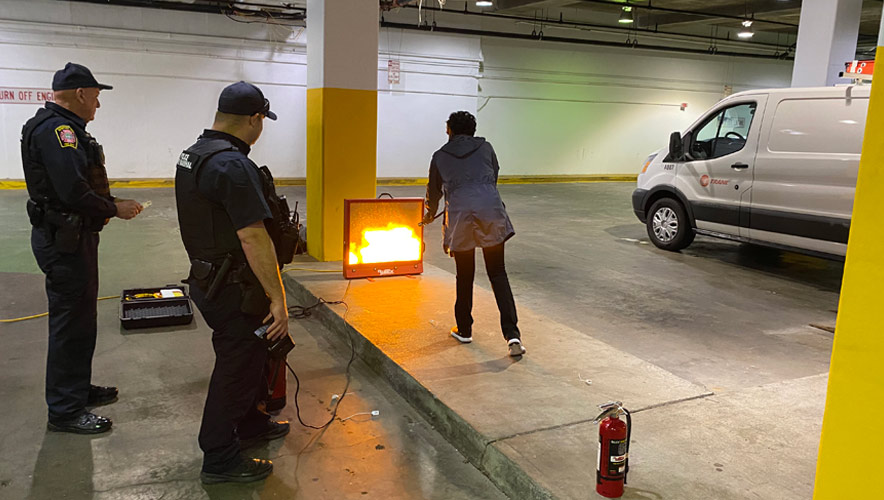How a Virginia City Built an Effective Volunteer Security Reserve Program
People are the most expensive and vital component of any successful security operation. The right person at the proper post with the necessary skills and resources can prevent a catastrophe, but just as readily the wrong person at the same post can create one.
Finding enough of the right individuals is not a new challenge facing security organizations, but it has become painstakingly more complex in the post-2020 environment. Security organizations are forced to compete in a shrinking labor market, with limited budgets, for personnel who are now being asked to take on greater responsibilities in a much more dynamic risk environment. Many are losing because there simply aren’t enough security officers to meet the demand.
The City of Newport News, Virginia, found a solution to this challenge by leveraging a long running but underutilized floor warden program.
Originally created primarily for fire events, floor wardens were volunteer employees representing all of the tenants in a multistory facility. They were tasked with the accountability of their employees during a fire evacuation. The city’s floor wardens received minimal training, often consisting of a roster and clipboard handed down from the previous warden with instructions to lead the evacuation from the floor should the alarm go off.
Without a central point of direction and coordination, the program suffered from employee attrition because there was no incentive or directive to replace floor wardens who had left their jobs. Some floors and departments—where no interested parties joined the program—went unrepresented. The result was a loosely organized group of volunteers who were eager to serve their workplace and coworkers but lacked the skills, resources, and direction to do so effectively.
The city’s security leadership saw an opportunity to expand the wardens’ roles and capitalize on their desire to serve by providing both direction and training to the participants. Planned in 2019 and launched in January 2020, the new Safety and Security Floor Leader Program focused on expending the participants’ roles from a fire event focus to an all-hazards approach. This meant that participants could continue to assist with fire evacuations, but they would also play a role in other in incidents such as medical emergencies, utility failures, hostile intruders, and weather events. In addition, the program expended to include three new, but equally vital tasks: reporting unsafe conditions or activities to city and department management, sharing vital safety and security information with their colleagues and peers, and reviewing or recommending buildingwide safety and security enhancements.
The team was assembled by soliciting volunteers from each tenant department within the facility, and—with some exceptions—was primarily made of volunteers of the previous warden program. There were some expected challenges. The formation of the team was delayed by COVID-19 lockdowns, and anxiety was high among many participants. These were not public safety employees, and they were hesitant and concerned about what they may be asked to do.
Engaging with city senior leadership was vital to the successful launch of the revised program because it reinforced the need for universal participation and opened avenues for interdepartmental cooperation. Bringing in professional public safety partners allowed for quality, real world, in-house instruction.
The team met monthly for the first year to establish a rhythm and conduct training. Each meeting covered a predesignated topic, beginning with understanding floor leaders’ roles and responsibilities on the team before addressing a broad range of areas—from inclement weather to active shooters.
Whenever possible, experts were brought in to assist with the presentations—with some topics receiving multiple training days. The city’s Fire Marshal’s Office provided training on fire response and evacuation, for example, allowing for detailed discussion of not only where and when to evacuate, but also what to expect from a fire department response.
Security personnel provided a basic awareness level training to participants in the Civilian Response to Active Shooter Events and Avoid, Deny, Defend response protocols. The program partnered with the Virginia Department of Criminal Justice Service to provide additional in-depth training on this topic. The emergency management department helped with training in inclement weather emergencies. Significant time was spent working with human resources to train floor leaders on the city’s anti-harassment and anti-bullying initiatives, as well as reporting requirements.
Most training sessions occurred virtually every month because all participants still had their regular full-time roles around the city. Approximately 20 percent of training events occurred in person, however, including CPR/AED training and hands-on fire extinguisher training. This allowed participants to use realistic fire extinguisher simulators to fight simulated fires. The training sessions were all designed to build critical life safety skills for the team members should they have to face a real emergency and to help build their confidence in the city’s commitment to keeping them and their colleagues safe.

In addition to valuable training, each meeting also included a chance to share vital information about trends, threats, and updates, as well as an open discussion on safety and security topics of concern to the participants.
This turned out to be an invaluable opportunity to not only build trust with the participants, but also to ensure that accurate information was shared in a timely manner with frontline employees. Through the peaks of the pandemic, civil unrest, contentious elections, and a rise in mental health incidents, city and security leadership had a direct conduit to employees for communicating constant and rapidly evolving information on mask mandates, screening protocols, access control solutions, and threat awareness.
In return, these same employees were sharing information back with city and security leadership, providing vital situational awareness of the employee morale and anxiety across facilities. These discussions proved their usefulness time and again because they allowed leaders to be more proactive in identifying potential issues and addressing them before disrupting operations. This included quickly correcting misunderstandings and misinformation that employees had about mandates or masking enforcement, changes in firearm laws, and security incident response expectations. On one occasion, participants were able to update and redirect employees who were moving to the wrong assembly area during a fire alarm evacuation.
To be sure, safety and security floor leaders do not and cannot replace properly trained security personnel. That is not their intent. Any organization of the size and scope of the City of Newport News will require well trained professional and uniformed security personnel to respond to critical incidents within their facilities.
But safety and security floor leaders can serve as a force multiplier—they can provide an extra set of trained eyes and ears within and around the facility that know what to look for and how to report it. This capability augments the existing professional security staff at minimal cost to the organization because the employees are already in the facility performing their regular duties.
Finally, in an extreme emergency, when the facility or its occupants are endangered, these individuals can lead in evacuating, locking down, or otherwise mitigating the impact of the emergency on the employees around them until professional rescuers and responders can take over.
Yan Byalik, CPP, is the security administrator for the City of Newport News, Virginia, and he has managed security organizations of varying sizes in higher education, municipal, and entertainment sectors. He is a graduate of Virginia Tech, and he currently serves as the ASIS RVP for Region 5A.






